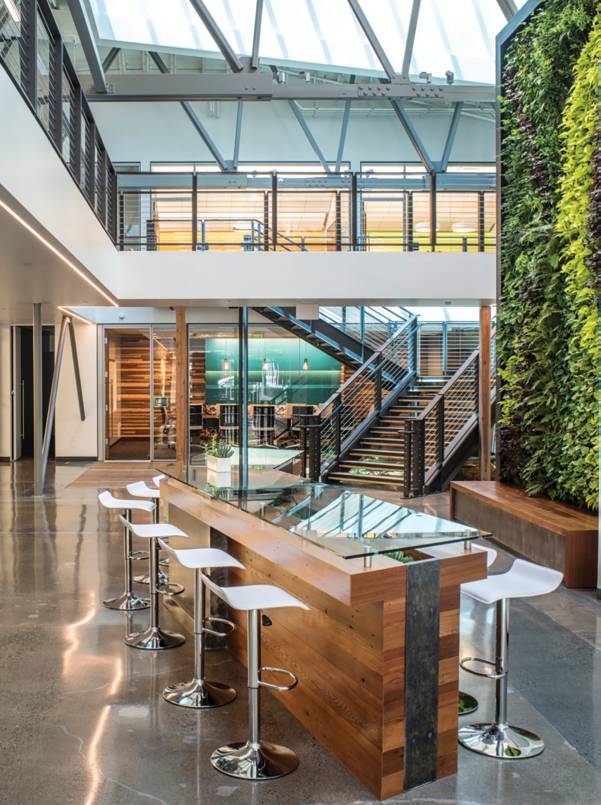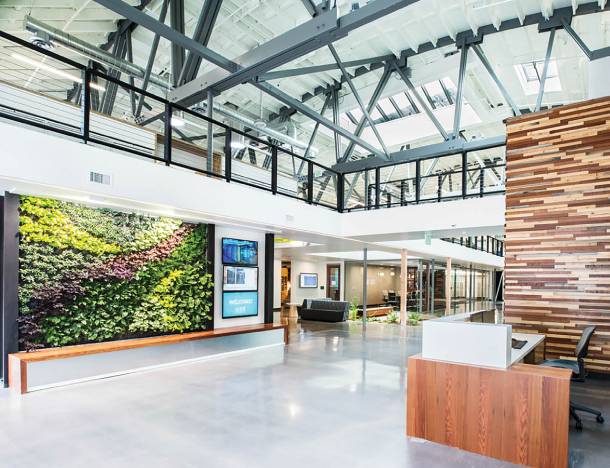THE TREND TOWARD HEALTH AND WELLNESS IN BUILDINGS
Thankfully, the mainstream real estate industry — including the architecture, design, and construction sectors — is embracing health and wellness in a meaningful and unprecedented way. Building owners and design teams can now use rating systems, including the International WELL Building Institute’s WELL Building Standard and the Center for Active Design’s Fitwel certification, that are informed by medical research in order to guide the design, construction, and operation of buildings toward promoting occupant health and wellness. Furthermore, the most popular green building standards are updating materials section requirements to focus on human health impacts in addition to environmental impacts. The International Living Future Institute — which runs the Living Building Challenge, the world’s strictest green building standard — maintains a popular Red List of carcinogenic and otherwise harmful chemicals that should be avoided in building products and materials. And the Global Real Estate Sustainability Benchmark (GRESB) recently added a Health and Well-being Module to its annual assessment tool.
While green or sustainable buildings are related to healthy buildings, they are not synonymous. Instead, the trend toward health and wellness in the real estate industry is a complementary counterpart to the green building sector, which emphasizes the environmental impact of buildings instead of their effect on occupants. Yet by pushing the envelope for sustainability in the built environment, the green building industry has opened people’s minds to what a building is capable of and conditioned us all to expect more out of our buildings, which in turn has paved the way for the healthy building movement. Now, in just a few years, the healthy building movement has seen a higher adoption rate than green building did at the same early stage.
HOW TO MAKE WORKPLACE BUILDINGS HEALTHIER
These specific strategies to promote health and wellness can work in both new and existing office buildings.
1. PRIORITIZE NATURAL LIGHT
Lighting, both natural and artificial, is a great place to start improving a building’s influence on health for occupants. Lighting is critical for facilitating vision, but also influences our bodies. Humans evolved outdoors, under natural cycles of light and dark, exposed to ever-changing light quantity and color spectrum throughout the day. This exposure turns out to be intergral to the body’s regulation of hormones that keep key processes related to alertness, digestion, and sleep functioning properly on a 24-hour cycle known as the circadian rhythm. Unfortunately, most indoor electric lighting typically provides one light level at a constant light temperature (color). Typical fluorescents, ubiquitous in office buildings, have particularly poor color distribution and do not render colors accurately.
Lighting is especially important because of its relationship to facilitating or hampering healthy sleep. Somewhere between 50 and 70 million US adults have a chronic sleep or wakefulness disorder, which is associated with increased risk of diabetes, obesity, depression, heart attack, hypertension, and stroke. Better lighting in workplaces could help.
Start by doing what you can to bring in natural light, which will benefit the entire human body. Be careful to ensure, however, that daylight will not cause discomfort to the visual system in areas with computer screens or where critical visual tasks are performed. To diffuse lighting, use light or medium-toned mesh shades that will let light in even when shades are down, and move them up and down as the light changes. You can also install special blinds that throw light onto the ceiling, or install standard curved blinds upside down. For taller glazed windows, consider using a light shelf at about 7 feet 6 inches to redirect light onto the ceiling. There are also several new dynamic film technologies that can be applied to existing windows that change to allow different amounts of light in. Ensure computer screens and writing surfaces close to windows are properly angled; 20 degrees away from the vertical plane of the nearest window is a good rule of thumb. In new buildings, make sure architects are considering the relationship between window sizing, depth of the building, and building orientation to get the perfect balance of comfortable natural light.

Natural light is important to a quality workspace. Photo: FME Architecture + Design
2. IMPROVE ELECTRIC LIGHTING
Although electric lighting is no substitute for daylight, there are several design choices that will result in a superior electric lighting system that minimally disrupts our biology. Select bulbs and lamps that have high color rendering index (CRI) values and high R9 values; the latter number indicates how well the lamp will display warmer tones, including skin. Consider using tunable LED lighting capable of varying in color temperature throughout the day to mimic the changing color of outdoor light and a system that automatically dims electric light in response to available daylight. If changing the whole lighting system isn’t possible, start by improving task lights at work stations. If possible, involve a lighting professional in selecting lamps and fixtures, as not all bulbs are created equal.
Make sure to properly shield electric light fixtures — no bright, bare bulbs — to prevent eye strain and blinding; have you ever looked directly at a light and then seen dark splotches for minutes after looking away? Avoid fixture placement that could cause direct glare on computer screens. And select finishes for the ceilings, walls, and floors with high reflective values to contribute to even lighting distribution.
Employees can also protect their eyes from their computer screens using glasses that block harmful blue light or by installing programs like f.lux that automatically adjust light intensity and screen color temperature based on time of day and year.
3. TAKE STEPS TO IMPROVE INDOOR AIR QUALITY
The air inside buildings has a tremendous impact on human health. It’s not unusual for indoor air quality (IAQ) to be worse than outdoor air quality. Think about it: Outdoor air, which often contains pollutants, gets brought in and further contaminated by one or more sources of indoor air pollutants, including off-gassing building materials, indoor combustion (e.g., gas stoves), water leaks, particles brought in on people’s shoes, chemicals used for cleaning, the accumulation of germs on high-touch surfaces, and more.
Studies show that certain aspects of IAQ, namely volatile organic compound (VOC) and carbon dioxide concentrations, directly and significantly affect cognitive function capabilities — including strategic ability, crisis response time, and activity performance: in other words, the key measures of productivity. Poor IAQ can also lead to acute health effects, including the various nonspecific symptoms of sick building syndrome such as eye, skin, and airway irritation and headache and fatigue.
Because indoor air quality depends on myriad factors, there’s not a one-size-fits-all solution for improving it. But the following best practices apply to nearly every building; notice that they involve both design choices and operational practices.
3.1. VENTILATE!
One easy way to ensure indoor air quality is healthy is to dilute it by bringing in ample filtered outside air, which keeps carbon dioxide levels low. In other words, ventilate properly. When spaces are densely occupied, ensure that ventilation levels increase automatically to keep carbon dioxide down, which will keep employees alert and act to flush out other indoor pollutants — and keep in mind that carbon dioxide concentration is a proxy indicator for other indoor pollutants. Some places and spaces should also use advanced filtration techniques; the type needed will depend on climate and outdoor air quality, among other factors.
3.2. TAKE A LOOK AT YOUR CLEANING PROGRAM
A green cleaning program should include regulation of cleaning products, vacuum filtration requirements, and specific instructions for care of high-touch surfaces and special training on chemical safety, equipment service, and product purchasing for cleaning staff. There are several resources to consult for guidance on developing a holistic, well-rounded program. For instance, EcoLogo, Green Seal, and the EPA’s Design for the Environment (DfE) are all eco-label certifiers. Products like hard-surface cleaners or odor-control additives that have one of these labels have chemical ingredients that have been approved from the standpoint of human health, ecological toxicity, and end-of-life impact. Choosing products with these labels means you are prioritizing ingredients that pose the least concern among chemicals in their class, thereby reducing potential hazards associated with the use of cleaning products.
3.3. SELECT PAINT, CARPETS, FURNITURE, AND OTHER MATERIALS THAT DON’T OFF-GAS
Careful selection of materials prone to off-gassing is critical to ensuring materials installed indoors don’t contribute to indoor air pollution. There are myriad standards that limit the VOC emissions and VOC content of these different families of products. Contractors and furniture, fixture, and equipment vendors should meet these standards. There are also ways that IAQ can become interactive for the users. RESET is a simple building certification standard dedicated entirely to indoor air quality and involves modeling all materials being used that emit VOCs to ensure the space will not exceed safe VOC levels over time. Additionally, RESET requires the ongoing monitoring and public display of the common indoor air quality indicators, including carbon dioxide and VOCs.

Living walls help indoor air quality. Photo: FME Architecture + Design
4. ENCOURAGE HEALTHY DIETS AND EXERCISE
Buildings can directly influence diet and activity. Stairs in a highly visible area with an alluring design that plays with elements like lighting, art, sound, or music can encourage occupants to use them more, for example. Employers can also encourage exercise by providing fitness equipment in an onsite gym or subsidizing gym memberships, incorporating active furniture such as standing or treadmill desks into workplace design, and encouraging biking to work by offering rewards or convenient services like showers and bike parking. The physical work environment can also influence diet: Employers can easily provide free fruit and vegetables and healthy snacks while limiting sugar and saturated fats in snacks and beverages available, for example, in vending machines.
5. IMPROVE OVERALL LOOK AND FEEL
Design choices determine the general feeling an occupant gets from a space, which in turn relates to that person’s stress level. Owners, employers, and design teams should carefully consider overall layout and flow; scale of rooms or spaces, including ceiling height compared to room width and depth; color and pattern of walls, floors, and ceilings; visual cues like signage to promote comfortable navigability; access to windows with views; and incorporating elements that evoke nature. There are some consultants and architects who specialize in what is called biophilia, the idea that humans possess an innate tendency to seek connections with nature and other forms of life. One resource on incorporating biophilic design elements is the report “14 Patterns of Biophilic Design” by Terrapin Bright Green. An interested company should seek a consultant or an architect who has an explicit focus on biophilic design, or engage in talks early in the design phase so it can be incorporated in a meaningful way.
6. ADOPT OTHER POLICIES THAT PROMOTE HEALTH
In addition to promoting better health through the physical elements of the building, employers can do so through company policies. For instance, a healthy sleep policy might limit how late people can work, allow napping at work (coupled with providing dedicated nap spaces), and subsidize technology that helps monitor daytime behaviors related to sleep, such as caffeine intake, eating habits, and activity levels. Adopting policies that limit aspects of business travel is another way of promoting overall health; for example, such policies might set limits on the ratio of total travel time to trip duration, include a certain number of days of personal time in business trips, and ensure employees have access to fitness opportunities at their destination, among other things.
THE BOTTOM LINE
People are a company’s greatest asset — which is also to say that people are a company’s greatest cost. For every dollar an organization spends on design and construction, it spends $1,000 on employees. So anything that prevents employees from doing their jobs — illness, lack of focus, fatigue, etc. — is costly to the employer. Investing in employee health and wellbeing through building features and operational practices can help attract and retain talent and help the bottom line.
sidebar
A LITTLE HEALTHY BUILDING HISTORY
There are endless reasons to be excited about the healthy building revolution that we’re in the midst of. But it’s important to remember that this is not just a fad; rather, the industry has come this far thanks to the research and relentless hard work of seemingly disparate professionals such as toxicologists, green chemists, architects, urban planners, behaviorists, researchers, physicians, and even average citizens who have taken action after their lives were negatively affected by environmental pollutants. Additionally, this movement is a response to a dire healthcare need. Americans’ lifestyles are harming and even killing them. The leading causes of death over the last century have shifted from infectious diseases to preventable diseases.
According to Dr. Michael Roizen, chief Wellness Officer at the Cleveland Clinic, 75 percent of chronic disease in the US today is attributed to stress, physical inactivity, food choices and portion size, or tobacco use. In fact, much of what is contained in the building standards mentioned has been incorporated specifically to help address these health statistics. Further, environmental pollutants linked to cancer and other diseases are still commonly found in the air we breathe, the water we drink, and objects we interact with daily. Studies show that average Americans, as well as those who go out of their way to avoid toxic substances, have measurable and often shocking levels of chemicals in their bodies.
Thankfully, it’s these studies, in addition to ever-growing public awareness of the inextricable link between environmental pollutants and human health, that have brought us to this exciting time.
Kristen Magnuson works at stōk, a comprehensive real estate services firm for impact-oriented organizations. She’s a member of stōk’s Performance Design team, which uses building science and human health research to inform a data-driven, systems-thinking approach to creating high-performing, life-enhancing spaces. Connect with her at kristen@stok.com.




